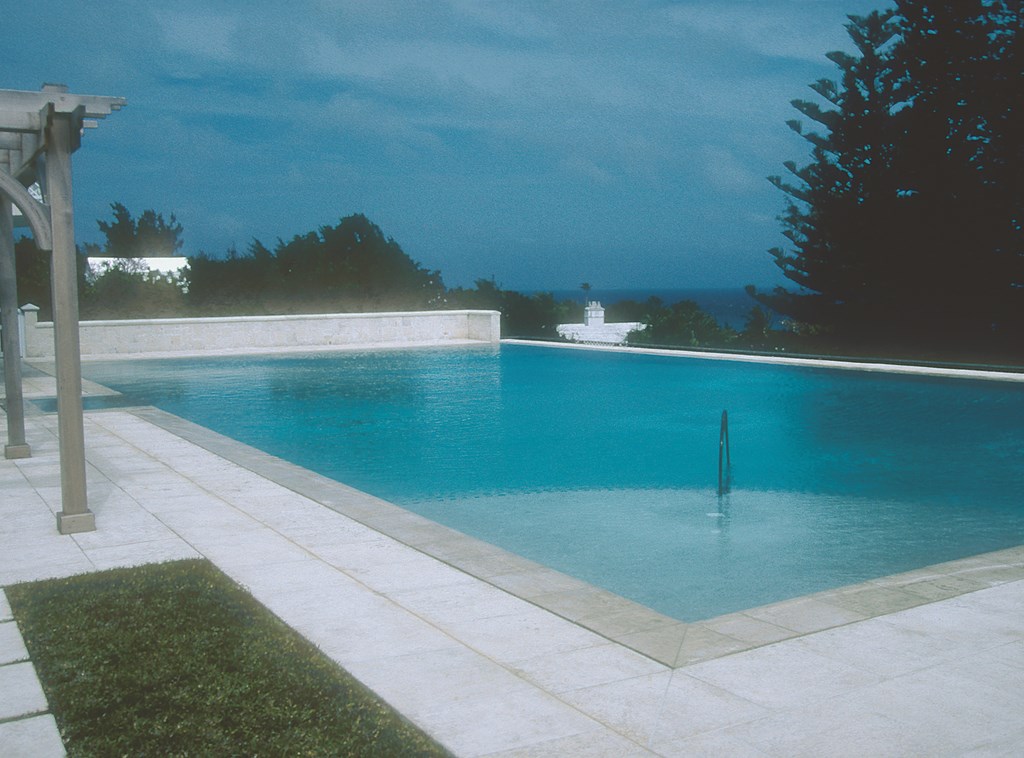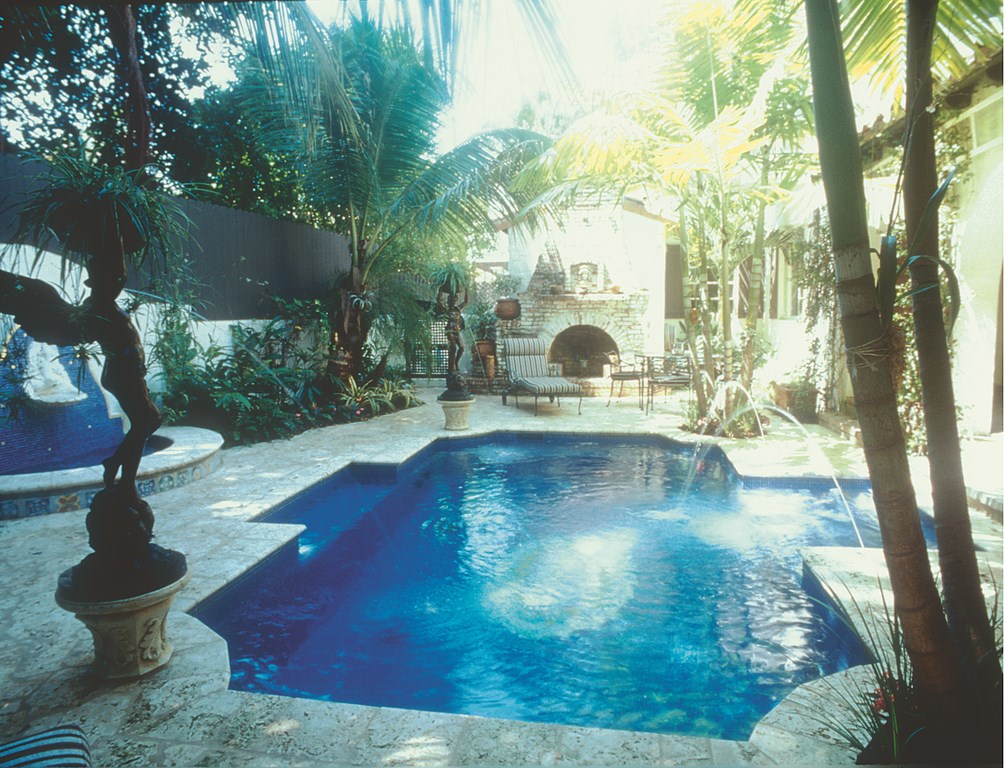Proportional Response

One of the real tricks in any art form can be the challenge of exercising restraint. Bigger isn’t always better, and both scale and size do matter. In other words, just because you can create something grand, it doesn’t always mean that you should.
This principle of proportionality has a sharp, specific meaning in the world of the custom watershaper, especially when clients ask for something that is oversized for the property or more elaborate than called for by the setting or surrounding architecture. We all know where it comes from: Clients have seen something they like, and it drives them to ask for features or an overall project scope that is simply too much for the available space.
And we have a natural tendency to go along: After all, we’re in business to please our clients, and we also have an urge as businesspeople to include lots of features that will make us money and give us a chance to demonstrate our ability to create sophisticated projects. Often, the result is that a client ends up with something that is out of whack, out of balance and out of scale for the setting and even for its intended use.
GROWING INTEREST
In large measure, this problematic tendency toward grandeur is the result of some otherwise positive trends.
A great many clients these days, for example, are collecting a tremendous amount of information about design possibilities and features from an increasing number of publications and resources about everything from pools and spas to streams, ponds and fountains. And with the advent of design-oriented shows on cable television – specifically on HGTV but even the Travel Channel – prospects are seeing more and more beautiful watershapes put on display and discussed in detail.
In many instances, these publications or broadcasts feature extremely high-end work, quite often situated on extremely large properties. Clients may get excited by what they see (and rightfully so), but they fail to consider that their own space is a fraction the size of what they’re seeing.
We know that client desires are built up over time and that, by the time clients are ready to take steps into the world of watershaping, they often come to the process with large sets of ideas. That’s great and helpful – but less so when their dreams don’t align with the space they have at their disposal. More and more, I for one am finding this to be an issue.
When you stop and think about the list of elements and embellishments so common to projects these days, it’s easy to see how things can very quickly go over the top in terms of scope and scale. Things that were rare even ten years ago are in everyone’s mind these days, and we can expect clients to inquire about every conceivable permutation and combination of beach entries, waterfalls, grottos, slides, lounging areas, streams, bars with submerged barstools, bridges, islands, all manner of rockwork, various edge treatments, tile mosaics, overhead structures, decks, cooking and entertainment areas, lazy rivers, sculpture areas, fire effects and even fish tanks.
These are all wonderful ideas in the right context, but I believe we need to ask our clients and, ultimately, ourselves: Do they work in the space we’re being given?
I’ve seen many projects where it looks as though the client ran through a laundry list of wants and the design/build team gave it to them with little or no thought to proportion or to how all of these various elements would work together visually or even functionally. At some point, the fact is that those who are serious about performing at a higher level, particularly in design, must learn the gentle, subtle art of restraint.
LESS CAN BE MORE
Restraint begins with the obvious point that you have to be able to fit a project into a given space while leaving room for landscaping, decks and areas where people can comfortably move around the watershape.
One of my Bermuda projects, just completed, has a pool measuring 75 by 45 feet. That’s truly a large body of water in a residential setting, but considering that the pool graces a 12-acre estate, it doesn’t seem large at all. The house is three stories high, and there are five other houses on the same one-family compound. The pool may be enormous, but it’s in a grand setting and would look out of place were it much smaller.
| When space allows, a pool as large as this one – quite expansive for a residential watershape at 75 by 45 feet – can fit comfortably and gracefully within the scale and dimensions of an outsized backyard. |
By contrast, another of my projects was placed into a yard so small that it’s a comparatively tiny 18 by 10 feet. In this cramped space, everything had to be thought out precisely with respect to spatial relations, beginning with the basic parameters for a pool that had to be small to exist.
The small yard, of course, didn’t alter that fact that these clients were no different from the owners of the behemoth property in their desire for something special. So we worked to enhance the small pool, using rich materials and top-flight detailing to draw attention and demonstrate that what the vessel lacked in size, it more than made up in visual interest and appeal.
On that point, I’ve always held that small projects afford the designer an opportunity to “turn up the volume” by using higher-quality materials to outstanding effect. First of all, the costs associated with using expensive materials are tamed by the small space. In addition, observers will be viewing and absorbing the work from what is necessarily an up-close perspective.
By using quality tile, natural stonework or other materials, you can keep things simple and allow beautiful colors, textures and reflections to come forward. This is why, in smaller spaces, I often try to nudge clients toward designs that include fewer and simpler visual elements. In the small yard discussed just above, we were also careful to blend the watershape’s design into the architecture of the home so that it was congruent with everything around it – in shape, style and basic design as well as materials.
MAXIMIZING POTENTIAL
When confronted by the small spaces that are increasingly common in today’s urban and suburban neighborhoods, I often begin by focusing on areas that will not contain the watershape.
I work with local codes and determine things such as clearances and setbacks from property lines, but it’s also a matter of applying some common sense or thinking in terms of functionality. Although in most situations that means locating the watershape someplace other than the middle of the yard, it doesn’t always mean pushing the water as far from the house as possible. In fact, I’ve found in small spaces that you can use relative intimacy with the water to your design advantage.
I’m currently working on a project in Boca Raton, Fla., for example, where the distance between an existing covered patio and the rear property line is just 24 feet. In this case, making things work has meant bringing the pool in close to the covered area – and even placing a portion of the pool’s steps beneath the existing patio cover.
In addition, we’re going to bring dual functionality to this covered area by incorporating a fountain and creating a focal point that can be seen and enjoyed from inside the house. Rather than exile the pool, we’ve integrated the space and tied everything comfortably together.
Without bringing the pool so close, we would’ve been limited to about 12 feet of pool width. As it is, we’re working instead with 18 feet of width. And we’ve used the extra span to maximize the potential view across the water, both from the deck and from inside the house.
In this situation, in other words, we chose to increase the visual significance of the watershape rather than minimize it by pushing the water away from the house. We’re also making simple (yet rich) material selections to blend with the shade structure, which features a beautiful, honed-limestone decking inlaid with diagonal brick borders.
Another step we’re taking involves the landscape lighting: Adjacent to the home is a large church property containing a huge oak tree that looms over my clients’ yard. We’re going to “adopt” the tree by uplighting it and drawing it into our space, leading the eye above and beyond the dark perimeter hedges at night.
JUST SAY ‘NO’
Implied within all of this discussion is a key point: If you’re going to design great spaces for your clients, you need to learn to say “no” in certain situations. It’s empowering when you gain the courage of your design convictions, and I’ve found that clients who are interested in finding the very best ideas for the space they have available will respect a strong opinion – even if it’s negative – so long as your position is reasoned and you can communicate exactly what you mean.
Staying with the Boca Raton project as an example: The homeowners initially wanted raised patios on either side of the pool, the thought being that changes in elevation would lend variety and visual interest to the small space. They also wanted to create a step down from the patio into a narrow area around the pool.
| When the available space is small, you need to rein in proportions, details and ornaments, consider your design in more intimate terms and keep the watershape from overwhelming its setting. |
To my eye, these elevation changes would have broken up the space in a way that would make things feel cramped and claustrophobic, so I urged them to keep everything on the same level and thereby impose a sense of visual continuity and spaciousness even within the small yard. If we split the level between the patio and the area immediately around the pool, I told them, both spaces would be compromised.
After some discussion, my clients came to appreciate the idea of keeping things simple and heeded my advice – testimony to the value of open communication and to the fact that they respected my need to tell them what I thought.
Another example: New clients have an existing (and truly horrible-looking) pool that they rightfully want to replace. They have lots of ideas and see a lush, naturalistic, lagoon-style pool as the perfect complement to verdant landscaping and their backyard aviary. The yard is big enough to support the basic game plan and to accommodate a solid-overhead shade structure they want to use in setting up an exterior room.
It was all a “go” until they shared with me the thought that they also wanted the pool to feature a deck-level, perimeter-overflow system, at which point I told them I didn’t think it was a good idea. First, there was the formal appearance of the slotted deck in the context of the naturalistic style. Second, there would be a requirement for additional decking to capture the splash out. This conflicted with the desire to include more tropical landscaping elements, not fewer.
I shared my views: Although I think perimeter overflows are great and I have designed and built many through the years, deck-level systems offer a sleek look that’s simply inconsistent with a lagoon-style pool. And I felt good about saying “no” in this case because it was better for the clients and their project.
A QUESTION OF BALANCE
There’s a wonderful feeling that comes when you stand by your convictions in this way. As watershape designers, we generally know more about watershaping than do our clients. When we can use our senses of proportionality, scale and context and stand our ground when our clients’ desires conflict with what we know is best for the project, the results can be positive on many, many levels.
At first blush, what I’m saying here might seem to fly in the face of the notion that, as watershapers, we should do everything we can to make our clients happy. Quite the contrary. In fact, I’d argue that adherence to principles of proportion and scale – and learning to say “no” as the situation requires – are completely harmonious with the idea of healthy client relations.
I’m not imperious in what I do. Indeed, my clients with smaller projects are exposed to the same full menu of options I offer clients on large-scale projects based on the simple notion that our mission is to land on the right set of options. Clients with smaller properties tend to see their limitations pretty quickly, and it’s a simple process of guiding them along the best available paths. In that sense, scale and proportionality are not purely spatial issues, but stylistic and functional ones as well.
And once you nurture and internalize your own senses of proportionality and scale, you’ll find they reach into every layer of the design process – not just the initial ones having to do with where you place a watershape and how large it should be, but also those having to do with relative sizes of features within a design as well.
A common mistake, for example, has to do with oversizing a spa in relation to an accompanying pool – or oversizing waterfalls or spillways or other waterfeatures that are either too large or too vigorous or too noisy for the main body of water. I’ve also seen cases where color selections throw things out of whack.
To be sure, beauty is in the eye of the beholder, and if a client insists on building out a small backyard with a pool that covers three-quarters of the available space with water, then that ultimately is their choice.
How far you’re willing to go along with them is a decision only you can make. Speaking for myself, I rest easy knowing that the design principles and practices I use tend to suit the needs of the space, all while satisfying my clients’ desire for something truly special.
Brian Van Bower runs Aquatic Consultants and is a co-founder of Genesis 3, A Design Group; dedicated to top-of-the-line performance in aquatic design and construction, this organization conducts schools for like-minded pool designers and builders. He can be reached at [email protected].












